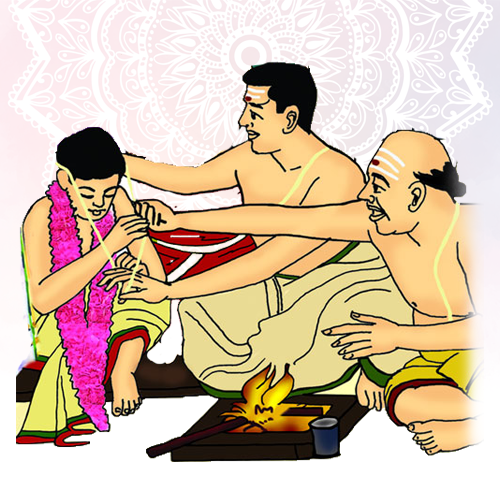
Yagnopavit Jenue Sanskar
Yagnopavit (Sacred Thread) Pooja: Meaning and Significance
Yagnopavit, also known as Upanayana, is a traditional Hindu ritual marking the initiation of young boys into the study of Vedic scriptures and their spiritual journey. It involves the sacred thread ceremony where the boy receives the Yagnopavit (sacred thread) as a symbol of his commitment to learning and adhering to dharma (duty and righteousness).
Steps and Procedure for Yagnopavit Pooja
-
Preparation:
- Choosing an Auspicious Date: Consult with a priest or knowledgeable person to select an auspicious date and time for the ceremony.
- Gathering Materials: Collect necessary items such as turmeric, sandalwood paste, kumkum (vermilion), flowers, fruits, betel leaves, betel nuts, rice, ghee, sweets, and a sacred thread (Yagnopavit).
-
Setting up the Altar:
- Clean and Decorate: Prepare a clean and sacred space or altar for the ceremony, adorned with flowers, rangoli (decorative patterns), and lamps.
- Arrange Pooja Items: Place all the pooja items neatly around the altar.
-
Invocation (Avahanam):
- Ganesh Pooja: Begin by invoking Lord Ganesha to remove obstacles and ensure a successful ceremony.
- Kalash Sthapana: Establish a kalash (pot filled with water) with a coconut on top, symbolizing the presence of divine energy.
-
Sankalp (Resolution):
- Taking the Sankalp: The boy (along with his father or guardian) takes a vow (sankalp) stating his readiness to undergo the Yagnopavit ceremony, uphold dharma, and pursue knowledge.
-
Main Pooja:
- Chanting Mantras: Recite Vedic mantras, including Gayatri mantra and other relevant hymns, under the guidance of the priest.
- Offering Items: Offer flowers, fruits, sweets, betel leaves, betel nuts, turmeric, sandalwood paste, rice, and water to the deities while chanting the mantras.
-
Yagnopavit (Sacred Thread) Ceremony:
- Purification: The sacred thread is purified with mantras and water before it is worn.
- Threading: The priest or father/guardian threads the Yagnopavit over the left shoulder and under the right arm of the boy, crossing the chest diagonally. This symbolizes his readiness to learn and uphold dharma.
-
Brahma Bhojan (Sacred Meal):
- Feeding Brahmins: Offer a traditional meal (often consisting of rice, dal, vegetables, and sweets) to Brahmins or priests as a gesture of respect and gratitude.
Benefits of Yagnopavit Pooja
- Spiritual Initiation: Marks the beginning of the boy's spiritual journey and commitment to learning.
- Knowledge and Education: Enhances the boy's dedication to acquiring knowledge, particularly of Vedic scriptures.
- Cultural and Traditional Preservation: Upholds ancient traditions and customs within Hindu culture.
- Family Unity: Strengthens family bonds through participation and support in the ceremony.
- Divine Blessings: Invokes blessings from the deities for success, prosperity, and spiritual well-being.
Yagnopavit Pooja, or Upanayana, is a significant rite of passage in Hinduism that symbolizes the initiation of young boys into the study of Vedic scriptures and their commitment to upholding dharma. By performing this pooja with sincerity and following the prescribed rituals, families ensure the spiritual and cultural continuity, while also seeking divine blessings for the boy's auspicious future.
 Add Temple
Add Temple